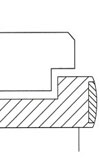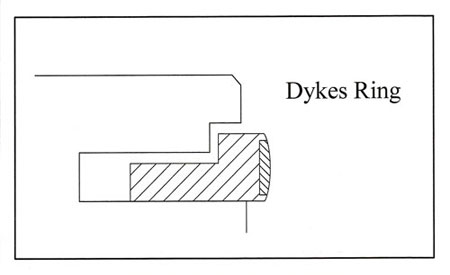The Dykes Ring
 There have been many different types of piston ring developed over the years. Rectangular, taper face, barrel face, scraper, Napier, torsional twist, reversed torsional twist to name but a few. But one particular version that seems almost totally forgotten today, except for a few highly specialised applications is that of the Dykes ring. Peculiarly 'L'-shaped in cross-section and named after it's inventor not an embankment built to prevent flooding as might be at first thought, the Dykes ring was a regular feature on many a racing engine in the nineteen fifties and sixties. In Formula One the Vanwall, Aston Martin, Coventry Climax, BRM, Weslake, Cosworth and Matra all used ring designs of this type at one time or another made in cast iron. In some cases only the top ring of a two or three ring pack would be of that design but in others, namely the Vanwall, the Aston Martin and Coventry Climax units this reverted to two per piston if the perceived benefits of the design were to be exploited to the full. Today the evolution of piston ring design has moved on and it is only in certain specialised categories of motor sport - mainly supercharged drag racing which the ring still maintains its attraction. But before we go into all these lets just remind ourselves of the function of the ring pack.
There have been many different types of piston ring developed over the years. Rectangular, taper face, barrel face, scraper, Napier, torsional twist, reversed torsional twist to name but a few. But one particular version that seems almost totally forgotten today, except for a few highly specialised applications is that of the Dykes ring. Peculiarly 'L'-shaped in cross-section and named after it's inventor not an embankment built to prevent flooding as might be at first thought, the Dykes ring was a regular feature on many a racing engine in the nineteen fifties and sixties. In Formula One the Vanwall, Aston Martin, Coventry Climax, BRM, Weslake, Cosworth and Matra all used ring designs of this type at one time or another made in cast iron. In some cases only the top ring of a two or three ring pack would be of that design but in others, namely the Vanwall, the Aston Martin and Coventry Climax units this reverted to two per piston if the perceived benefits of the design were to be exploited to the full. Today the evolution of piston ring design has moved on and it is only in certain specialised categories of motor sport - mainly supercharged drag racing which the ring still maintains its attraction. But before we go into all these lets just remind ourselves of the function of the ring pack.
Forming a seal between the piston and cylinder bore the goal is to prevent the passage of combustion gases between combustion chamber and crankcase on the one hand, and at the same time minimise the passage of oil from the crankcase up into the combustion chamber on the other. During the compression and power strokes the compression rings seal the combustion gases and control the exhaust blow-by while on the downward strokes, the excess oil thrown up onto the cylinder walls is scraped off and returned eventually back to the sump, leaving only a small amount of oil on the cylinder wall. Since the majority of parasitic losses occur in the ring pack in the form of friction, all this has to be done using the minimum of side force between ring and bore throughout the cycle.

The Dykes ring is therefore a lightweight 'L'-shaped ring with only a very low spring tension on the cylinder wall in the static condition. During the intake and exhaust strokes the arrangement will exert little in the way of side force on the cylinder wall but on the power stroke combustion gas can flow down past the increased gap around the top land and through the convoluted space between ring and piston and force the ring out against the bore. In this way, or so the theory goes, friction is only apparent during the combustion stroke. Furthermore, the reduced mass of the ring because of the ultra thin section minimises the chances of ring 'flutter' caused by acceleration and deceleration at high engine speeds. Additionally, machining the grooves into the piston required much more care than other arrangements.
Needing a special piston with groves to match, their asymmetric profile can make them hard to seat leading to higher bore wear. Replaced by more effective designs, other than in certain specialist applications, Dykes rings have now been consigned to history.
Fig. 1 - Cross-section of the Dykes ring.
Written by John Coxon